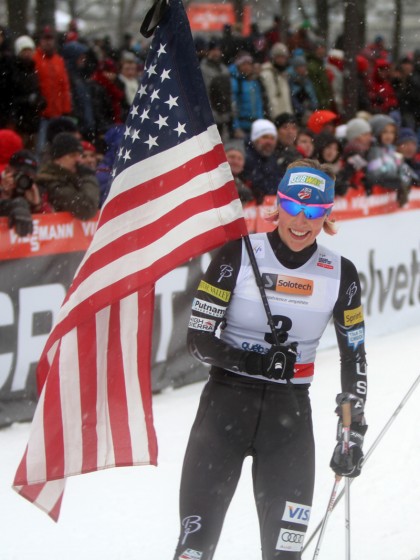
In this edition of our Q & A series, American star Kikkan Randall discusses specific workouts performed during her recovery from a stress fracture, and we break down the different race series, and how they relate.
If you have questions you would like us to answer, email us at questions@fasterskier.com.
I’m an older Master skier but would love to learn what kind of speed strength and other workouts Kikkan did while healing from her issues this fall. It sure seems to have worked for her and could be enlightening for all of us.
— Kim from Wyoming
Here are a couple of the workouts I did while healing my foot injury:
– Pool running intervals: 15 min warm-up, 20-30 min of 30 secs sprinting, 30 secs recovery, cool down.
– Upper Body distance: 30 min at solid distance pace on the Exer-Genie followed by 30 min at solid distance pace on the SkiErg.
– Double-pole intervals: warm-up, 4×10 min at threshold on rolling terrain, cool-down.
– Climbing on a mountain bike while staying seated, 90-120 mins at 75-85% of max heart rate.
– Upper body and core specific circuits in the weight room.
Recovering from an injury can be a great opportunity to work on your weaknesses and focus on improving specific skills. Stay positive and focus on what you CAN do!
Best of luck!
Cheers,
Kikkan
___________________
Can you explain the organization of race series across the country, continent, and World? Continental Cup, NorAm, SuperTour – define each of these and how they relate to each other and regional series like the Eastern Cup, as well as the World Cup and other European series.
— Zack in California
It would take more space than I have here to discuss every race series but this is a timely question with the 2013 still in the early stages.
We can begin at the top. The World Cup is the highest level of racing in the world – the major leagues as it were. The NorAm series and the SuperTour are Canada’s and USA’s entries in the Continental Cup.
So while the World Cup is a series, the Continental Cup is actually a classification of series. In addition to North America’s two circuits, there is a Scandinavian Cup and a Balkan Cup among others.
These represent the highest level of the minor leagues, and skiers racing in these events usually aspire to the World Cup. And that aspiration can be fulfilled in a practical way. At various points in the season, the leaders of Continental Cups are granted World Cup start spots in addition to national quotas. This is how Holly Brooks started the season on the World Cup last year and provides a clear path to the big show.
After this, however, things start to get less defined, with no real relation or hierarchy.
The main delineator is FIS points. A race is either scored for such points or not. All World Cup and Continental Cup races are by default. FIS points are the currency of the professional and aspiring skier, impacting team selections, start seeding, and ranking lists.
Such races generally must be held on homologated courses and often attract strong fields.
In the US, some collegiate races have been FIS sanctioned for points, and certain marathons are as well.
There is the elite marathon series in Europe – the Ski Classics, as well as the FIS Marathon Cup, and the World Loppet. Many of the events overlap, and participants include everyone from recreational skiers to Olympians.
The Eastern Cup is the New England Nordic Ski Association’s regional race series and act primarily as qualifiers for Junior Nationals. All regions that participate in Junior Nationals hold qualifying races, but they may not be presented as a “series.”
Ultimately only the Continental Cup and World Cup have a truly direct relationship. The rest may be tied together by FIS points or qualification criteria but are mainly separate entities.
Topher Sabot, FasterSkier



